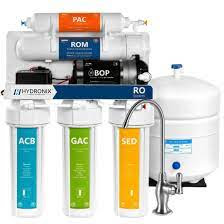The Cost of Reverse Osmosis Systems
Reverse osmosis (RO) systems are popular for purifying
water by removing impurities and contaminants. The cost of an RO system varies
based on several factors, including the type, size, and features of the system.
Here’s a breakdown:
- Under-Sink
RO Systems: These are the most common and typically
cost between $150 and $500. Installation costs might add another $150 to
$300 if professional installation is required.
- Countertop
RO Systems: These are less expensive, ranging from
$100 to $300, and are easy to install without professional help.
- Whole-House
RO Systems: These are more expensive due to their
capacity to purify water for an entire household. Prices range from $500
to $2,000 or more, with installation costs potentially adding several
hundred dollars.
- Commercial
RO Systems: These systems, used in businesses and
large facilities, can cost anywhere from $1,000 to $20,000, depending on
the size and complexity of the system.

5. Operating costs, including filter replacements and
electricity, should also be considered. Filter replacements typically cost $20
to $200 annually, while electricity costs are minimal but vary based on usage.
The Importance of Total Dissolved Solids (TDS)

Total Dissolved Solids (TDS) refer to the combined content
of all inorganic and organic substances in water, including minerals, salts,
and metals. TDS levels are a crucial indicator of water quality for several
reasons:
- Health
Implications: While a certain level of TDS is
essential for taste and nutritional value, excessive TDS can indicate
harmful contaminants. For instance, high levels of lead, arsenic, or
nitrate can pose severe health risks.
- Taste
and Palatability: Water with very low TDS can taste flat,
while high TDS water can taste bitter or salty. The ideal TDS level for
drinking water is typically between 50 and 150 ppm (parts per million).
- Appliance
Longevity: High TDS levels can cause scaling and
deposits in household appliances, reducing their efficiency and lifespan.
- Agricultural
Impact: In farming, TDS levels affect soil
health and crop yields. Water with high TDS can lead to soil salinization,
adversely impacting plant growth.
Health Risks Associated with Contaminated Water
Contaminated water poses significant health risks, as it
can harbor pathogens, chemicals, and heavy metals. Diseases associated with
contaminated water include:
- Cholera:
Caused by the bacterium Vibrio cholerae, it leads to severe diarrhea
and dehydration, potentially fatal without prompt treatment.
- Dysentery:
Resulting from infections like Shigella or Entamoeba histolytica,
dysentery causes severe diarrhea, often with blood.
- Hepatitis
A: A viral infection affecting the liver, spread
through ingestion of contaminated water or food.
- Giardiasis:
Caused by the protozoan Giardia lamblia, it leads to digestive
issues, including diarrhea and abdominal pain.
- Arsenicosis:
Chronic exposure to arsenic in water can cause skin lesions, cancer, and
cardiovascular diseases.
- Lead
Poisoning: High levels of lead in water can cause
developmental issues in children, and kidney and nervous system damage in
adults.
6 Steps to Ensure Safe Drinking Water

To protect health and ensure safe drinking water, consider
the following actions:
- Install
a Water Purification System: Investing in a good
quality RO system can effectively remove contaminants. Regular maintenance
and timely replacement of filters are essential.
- Regular
Water Testing: Periodically test water for TDS and
specific contaminants. This helps in identifying issues early and taking
corrective actions.
- Boil
Water: Boiling water can kill most pathogens, making it
safe for drinking. However, it does not remove chemical contaminants.
- Use
Water Purification Tablets: These can disinfect
water in emergency situations, making it safe to drink.
- Community
Awareness: Educate your community about the
importance of water purification and safe water practices.
- Government
Programs: Support and advocate for government
programs aimed at providing clean water infrastructure and regular
monitoring of water sources.
By understanding the costs and benefits of reverse osmosis
systems, the role of TDS in water quality, and the health risks associated with
contaminated water, individuals and communities can take proactive steps to
ensure their water is safe and healthy.
Click here to get it for free






Comments
Post a Comment
If you have any query, doubt or seek any advice or help, I am always available.